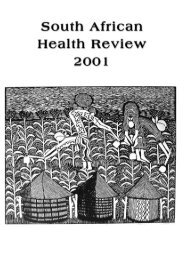The Status of Clinic Committees in Primary Level - Health Systems ...
The Status of Clinic Committees in Primary Level - Health Systems ...
The Status of Clinic Committees in Primary Level - Health Systems ...
Create successful ePaper yourself
Turn your PDF publications into a flip-book with our unique Google optimized e-Paper software.
An <strong>in</strong>terest<strong>in</strong>g picture emerges with regard to how long cl<strong>in</strong>ic committees have been <strong>in</strong> existence at the facilities.<br />
Across all the prov<strong>in</strong>ces, 75% <strong>of</strong> cl<strong>in</strong>ic committees had been <strong>in</strong> existence for 5 years or less; 12% had been <strong>in</strong><br />
existence for 6-10 years and 13% had been <strong>in</strong> existence for 11 years or more. In the Northern Cape 100% <strong>of</strong><br />
cl<strong>in</strong>ic committees had been <strong>in</strong> existence for 5 years or less while <strong>in</strong> the Free State and Mpumalanga Prov<strong>in</strong>ces,<br />
93% <strong>of</strong> cl<strong>in</strong>ic committees had been <strong>in</strong> existence for 5 years or less. Thus the data suggests that <strong>in</strong> most prov<strong>in</strong>ces,<br />
cl<strong>in</strong>ic committees have been <strong>in</strong> existence from roughly around the time that the National <strong>Health</strong> Act laid the<br />
framework for the existence <strong>of</strong> governance structures. However, <strong>in</strong> the Western Cape, 47% <strong>of</strong> cl<strong>in</strong>ic committees<br />
had been <strong>in</strong> existence for 5 years or less with 26% be<strong>in</strong>g <strong>in</strong> existence for 6-10 years and 27% for 11 years or<br />
more suggest<strong>in</strong>g that cl<strong>in</strong>ic committees have been <strong>in</strong> existence for much longer <strong>in</strong> the Western Cape than <strong>in</strong><br />
other prov<strong>in</strong>ces.<br />
4.7 <strong>Cl<strong>in</strong>ic</strong> committee: constitution and convener<br />
<strong>Cl<strong>in</strong>ic</strong> committees require a constitution to govern the manner <strong>in</strong> which they operate and to add weight to the<br />
roles and responsibilities <strong>of</strong> the members <strong>of</strong> the committee. Nationally, 75% <strong>of</strong> cl<strong>in</strong>ic committees reportedly have<br />
constitutions. This figure conceals large <strong>in</strong>ter-prov<strong>in</strong>cial disparities with as many as 98% <strong>of</strong> cl<strong>in</strong>ic committees<br />
<strong>in</strong> the Free State hav<strong>in</strong>g a constitution and 56% <strong>of</strong> cl<strong>in</strong>ic committees <strong>in</strong> Mpumalanga reportedly hav<strong>in</strong>g a<br />
constitution.<br />
Figure 8:<br />
<strong>Cl<strong>in</strong>ic</strong> committees with a constitution<br />
<strong>Cl<strong>in</strong>ic</strong> committees with a constitution<br />
100<br />
80<br />
Percentage<br />
60<br />
40<br />
20<br />
0<br />
EC<br />
FS<br />
GP<br />
KZN<br />
LP<br />
MP<br />
NC<br />
NW<br />
WC<br />
Total<br />
YES<br />
NO<br />
Despite the high number <strong>of</strong> facilities that reported hav<strong>in</strong>g cl<strong>in</strong>ic committees, respondents <strong>in</strong> the focus group<br />
discussions <strong>in</strong> KwaZulu-Natal described work<strong>in</strong>g without any guidel<strong>in</strong>es and requested assistance to develop a<br />
constitution:<br />
We just work without any guidel<strong>in</strong>es and we have to decide and see what work needs to be done<br />
and how. <strong>The</strong>re is no constitution. We are very happy now that you are here and hope that you<br />
will help us to eventually have our constitution.<br />
34
















